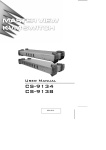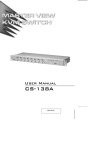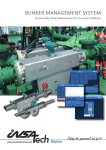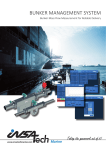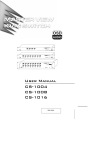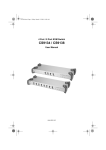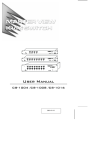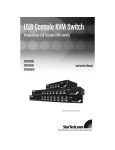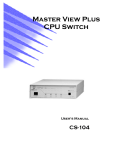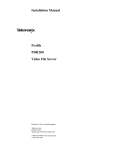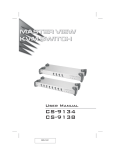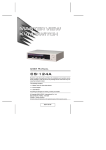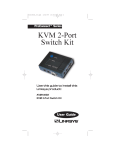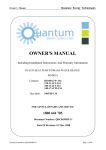Download ATEN CS-114A User manual
Transcript
PACKING LIST The complete Master View Pro package consists of: One CS-114 Master View Plus KVM Switch One Power Adapter One User Manual 4 PORT KVM SWITCH Please read this manual thoroughly and follow the installation procedures carefully to prevent any damage to the CS-114 and/or any devices it connects to. SPECIFICATIONS Specifications P ower consumption PC Connections 4 PC selected by Keyboard, Pushbutton or foot Switch LEDs 4 on line, 4 selected Scan interval connector POWER FOR PS / 2 & PC / AT Function DC 9V 250 mA (max.) 3, 10, 20, and 40 seconds K eyboard 5-pin DIN and 6-pin mini-DIN / female Serial Mouse 9-pin D type f PS/2 mouse 6-pin mini-DIN female Monitor High Density15-pin D type female / male emale Enclosure Metal Weight 2650g Dimensions ( L x W x H ) 254 x 180 x 82 (mm) ©Copyright 1999 ATEN® International Co., Ltd. Manual Part No. PAPE- 1151-100 Printed in Taiwan 06/1999 All brand names and trademarks are the registered property of their respective owners. Overview Hardware Requirements The Master View CS-114 4 Port KVM Switch is a control unit that allows access to four PC systems from a single console (keyboard, mouse, and monitor) in a cost effective manner. Console The Master View CS-114 provides three convenient methods to access the PCs connected to the system: using the push button Selection switches located on the unit's right panel; with an optional foot switch; and entering Hot Key combinations from the keyboard. Setup is fast and easy; plugging cables into their appropriate ports is all that is entailed. There is no software to configure, no installation routines, and no incompatibility problems. Since the Master View CS-114 intercepts keyboard input directly, it works on any hardware platform and with all operating systems. There is no better way to save time and money than with a Master View CS-114 installation. By allowing a single console to manage all of the attached PCs, the Master View CS-114 eliminates the expense of purchasing a separate keyboard, monitor, and mouse for each system. Additionally, it saves all the extra space they would take up, and eliminates the inconvenience and wasted effort involved in constantly having to move from one PC to the other. Features • Supports Microsoft IntelliMouse, Logitech FirstMouse, MouseMan... • Mouse Conversion: One PS/2 mouse controls all connected PCs - those that use PS/2 mice as well as those that use Serial mice* • Superior Video Quality; 180MHz bandwidth supports up to 1600x1200 @ 60 Hz • Hot Pluggable: PCs can be added, or removed for maintenance, without powering down the CS-114 • Easy to Operate - PC Selection Via Push Button Switch or Hot Keys • Caps Lock, Num Lock, and Scroll Lock, States are Saved and Restored When Switching • Auto Scan Function automatically switches through the powered up computers to monitor PC operation • NEXT/LAST Function allows users to cycle through the ports without leaving the keyboard • On Line and Status LEDs for easy status monitoring • Daisy Chainable to three levels • Easy to install - no software required - standard cables to connect to the PCs is all it takes • Saves time, space, power, and equipment costs * Translates PS/2 mouse protocol to MS mouse • One VGA, SVGA, or Multisync monitor capable of the highest resolution that you will be using on any PC in the installation • One PS/2 Mouse • One PS/2 Style Keyboard or AT Style Keyboard, plus a keyboard adapter PC The following equipment must be installed on each PC that is to be connected to the system: • A VGA, SVGA or Multisync card. • Either a 6-pin mini-DIN (PS/2 style), or DB-9 (standard serial), mouse port. • Either a 6-pin mini-DIN (PS/2 Style) keyboard port with +5V DC on pin 4 and Ground on pin 3, or a 5-pin DIN (AT Style) keyboard port with +5V DC on pin 5 and ground on pin 4. Introduction Front View: 1. 2. POWER FOR PS / 2 & PC / AT 3. 4. 5. 1. Selected LEDs Lights to indicate the currently selected port. Depending on the port's status, the LED may flash according to a specific pattern (see the table in the Appendix for details). 2. On Line LEDs Lights to indicate that the PC attached to the corresponding port is up and running. 3. K/M Reset If the keyboard and mouse get stuck and need to be reset, simultaneously press this Port1 / Port2 switch combination for three seconds. 4. Port Selection Switches Press a switch to access the PC attached to the corresponding port. 5. Power Switch Rear View: Installation Before you begin, make sure that power to all the devices (Master View CS-114 and PCs) you will be connecting up have been turned off. Single Station Installation 1. 2. 3. 1. Console Port Section Your monitor, keyboard, mouse, and DC 9V power adapter plug in here. 2. DIP Switch A four segment DIP Switch. Switches 1 and 2 select the Scan Time; Switch 3 has no assignment at this time; Switch 4 selects the Cascade Mode. See the table in the Appendix for details. 3. CPU Port Section The extender cables that connect the unit's monitor, keyboard and mouse ports to the PC's monitor, keyboard and mouse ports plug in here. 1. Set the Master View CS-114's DIP Switch 4 to the ON (Cascade Disabled) position. 2. Plug the monitor, keyboard, and mouse into the Console port connectors (located to the left of the CPU ports) of the Master View CS-114 unit. Each port is labeled with an appropriate icon to indicate itself. 3. Use either AT or PS/2 style extender cables to connect the keyboard and mouse ports from any available CPU Port (CPU1 - CPU4), to the keyboard and mouse ports of the PC, as shown in the diagram below. 4. Use a VGA extender cable to connect the CPU Port monitor port to the monitor port of the PC, as shown in the diagram below. 5. Plug the DC power adapter into the Master View CS-114's Power Jack. 6. Turn on the power to the Master View CS-114. 7. Turn on the power to the connected PCs. Note: You must turn on the power to the Master View CS-114 before turning on the power to the PCs. AT KEYBOARD PORT PS/2 MOUSE PORT PS/2 KEYBOARD PORT VGA MONITOR PORT VGA MONITOR PORT VGA MONITOR PS/2 MOUSE PS/2 KEYBOARD Two Stage Installation One to four Master View CS-114 units can be cascaded from the CPU Ports of the parent unit. The Master View CS-114s that connect back to the First Stage unit are considered Second Stage units. As many as 16 PCs can be controlled in a complete two stage installation. A table showing the relation between the number of PCs and the number of Master View units needed to control them is provided in the Appendix. To set up a two stage installation, do the following: VGA MONITOR PS/2 MOUSE PS/2 KEYBOARD 1. Make sure that power to all the devices you will be connecting up, as well as preexisting devices on the installation have been turned off. 2. Make sure that DIP Switch 4 of the First Stage Master View CS-114 is set to the ON (Cascade Disabled) position. 3. Make sure that DIP Switch 4 of all Second Stage Master View CS-114s are set to the OFF (Cascade Enabled) position. 4. Use extender cables to connect the ports from any available CPU Port (CPU1 CPU4) on the First Stage unit to the Console Port connectors of the Second Stage Master View CS-114. Note: When cascading, you must use AT type (5 pin DIN) extender cables for connecting the keyboard ports. 5. Plug the DC power adapter into the Master View CS-114's Power Jack. 6. Repeat the steps 2 - 5 for any other Second Stage Master View CS-114 units you wish to connect. 7. Use either AT or PS/2 style extender cables to connect the keyboard and mouse ports from any available CPU Port (CPU1 - CPU4), to the keyboard and mouse ports of the PC, as shown in the diagram below. 8. Use a VGA extender cable to connect the CPU Port monitor port to the monitor port of the PC, as shown in the diagram below. 9. Turn on the power to all the Master View CS-114 units. 10. Turn on the power to all the connected PCs. Note: You must turn the power to the Master View CS-114 units On before turning on the power to the PCs. Three Stage Installation The procedures for setting up a three stage Master View CS-114 configuration are essentially the same as for a two stage installation. With a three stage setup, however, as many as 64 PCs can be controlled in a complete installation. A table showing the relation between the number of PCs and the number of Master View units needed to control them is provided in the Appendix. Note: Master View CS-114 units can not be cascaded beyond the third level. Operation There are three ways to access any computer on the installation: by pressing the front panel Select Buttons, with an optional Foot Switch, or by entering Hot Keys from the keyboard. Once a computer has been accessed, the CPU Switch directs keyboard control, mouse control, and video image of that computer to you as if the computer were right next to you. Manual Port Selection Manual selection simply involves pressing the Port Selection switch on the front panel of the Master View CS-114 unit that corresponds to the PC that you want to access. After you press the switch, the Selected LED lights to indicate that the port is currently selected. To access a PC connected to a Second or Third Stage unit, you must press the appropriate Port Selection switch on the unit that connects directly to the PC you want to access. Foot Switch Selection An optional foot switch provides still another means to access an attached computer. Each time you step on the foot switch, the active focus switches to the next computer on the installation. The Selected LED lights to indicate that the port is currently selected. Hot Key Port Selection Hot Key navigation allows you to select the active PC directly from the keyboard. The Master View CS-114 provides several Hot Key navigation features. These are: Selecting the Active Port Auto Scan Mode Last/Next Mode Selecting the Active Port: Since each CPU port is assigned a unique numeric ID, you can directly access any PC on any level of the installation using a Hot Key combination that specifies the Port ID of the CPU Port that the PC is connected to. The steps involved are: 1. Press and simultaneously release Alt+Ctrl+Shift. 2. Key in the appropriate Port ID one digit at a time (see note below). 3. Press [Enter] to complete your selection. Note: The Port ID is a one, two, or three digit number that is determined by the Stage Level and CPU Port of the Master View unit that the PC is connected to. The first digit represents the CPU Port of the First Stage unit; the second digit represents the CPU Port of the Second Stage; the third digit represents the CPU Port of the Third Stage. For example, to access a PC attached to a First Stage unit, simply key in one digit that corresponds to the number of the port (1 - 4) that the PC is attached to for the Port ID. To access a PC attached to a Second Stage unit, key in a two digit number for the Port ID (press and release each number separately). The first digit represents the CPU Port (1 - 4), on the First Stage unit that the Second Stage unit is cascaded down from; the second digit represents the port number on the Second Stage unit that the PC is connected to. For example, a Port ID of 2 3 refers to a PC that is connected to CPU Port 3 of a Second Stage unit that, in turn, is cascaded down from CPU Port 2 of the First Stage unit. To access a PC attached to a Third Stage unit, key in a three digit number following the method described for the Second Stage unit. For example, a Port ID of 2 4 1 refers to a PC that is connected to CPU Port 1 of a Third Stage unit that is cascaded down from CPU Port 4 of a Second Stage unit which, in turn, is cascaded down from CPU Port 2 of the First Stage unit. Auto Scan Mode: Appendix The Master View CS-114's Auto Scan feature automatically switches among all the active CPU Ports of all the Master View units in the installation at regular intervals, so that you can monitor their activity without having to take the trouble of switching yourself. The amount of time it dwells on each port is determined with segments 1 and 2 of the DIP Switch located at the left of the Master View CS-114's rear panel (see the table in the Appendix for setting details). To invoke Auto Scan Mode, key in the following Hot Key combination: SELECTED LED Display: 1. Press and simultaneously release Alt+Ctrl+Shift 2. Press 0 (zero) 3. Press [Enter] Once scanning begins, it continues until you press the [Spacebar] to exit Auto Scan Mode. The port that was currently active at the time scanning stopped remains active. Activity Off On (Steady) Flashing (On short; Off long) Port is connected to a lower stage Master View CS-114. Flashing (On and Off equal) Port is connected to an active PC and is being accessed in Auto Scan mode. Flashing (On long; Off short) Port is connected to an active PC and is being accessed in Previous/Next mode. DIP Switch Settings Scan Time (secs) 3 10 20 40 Note: While Auto Scan Mode is in effect, none of the other keyboard keys will function. You must exit Auto Scan Mode by pressing the [Spacebar] in order to use the console for anything else. Last/Next Mode: The Last/Next feature enables you to quickly switch among computers in order to monitor them manually, instead of using Auto Scan Mode. This method lets you dwell on a particular port for as long or as little as you like - as opposed to Auto Scan Mode, which switches after a fixed interval. To invoke Last/Next Mode, key in the following Hot Key combination: 1. Press and simultaneously release Alt+Ctrl+Shift 2. Press 9 3. Press [Enter] Once Last/Next Mode is active pressing the left Shift key (LShift), switches to the previous computer (from the currently active one); pressing RShift switches to the next computer in the installation. Note: While Last/Next Mode is in effect, none of the other keyboard keys will function. You must exit Last/Next Mode by pressing the [Spacebar] in order to use the console for anything else. Meaning Port is not selected. Port is connected to an active PC. Cascade Mode Disabled Enabled Switch 1 On Off On Off X X 2 On On Off Off X X 3 X X X X X X 4 X X X X On Off Note: Switch 3 has no assignment at this time. It doesn't matter what it is set to. Master View - PC Connection Table The following table indicates the relationship between the number of cascaded Master View Units and the number of PCs that they control: MV Units PCs MV Units PCs MV Units PCs MV Units PCs 1 1-4 7 20 - 22 12 35 - 37 17 50 - 52 2 5-7 8 23 - 25 13 38 - 40 18 53 - 55 3 8 - 10 9 26 - 28 14 41 - 43 19 56 - 58 4 11 - 13 10 29 - 31 15 44 - 46 20 59 - 61 5 14 - 16 11 32 - 34 16 47 - 49 21 62 - 64 6 17 - 19 Troubleshooting Note: If you are experiencing problems, first make sure that there are no problems with the cables, and that they are all properly connected. Symptom Possible Cause Keyboard Loose cables. Not Responding* Keyboard needs to be reset. Master View needs to be reset. Master View is in Auto Scan Mode or Last/Next Mode. Pressing Hot Selected port Keys Gets connects to a powered Off No computer. Response. Hot Key sequence input incorrectly. Master View is in Auto Scan Mode or Last/Next Mode Loose cables. Mouse Not Detected, or Mouse needs to be Does Not reset Respond Correctly** Master View needs to be reset Mouse set to Serial Mode Incorrect Mouse Driver Video Problems Resolution and/or Bandwidth set too high Cable quality not good enough Action Check all keyboard cable connections to make sure they are completely seated in their sockets. Unplug the keyboard from the Console Keyboard Port, then plug it back in. Turn off the PCs and the Master View CS-114. Wait five seconds; turn the Master View unit on; then turn the PCs on. Press the [Spacebar] to exit Auto Scan or Last/Next Mode. Change the port manually by pressing the appropriate Port Selection switch. Resend the Hot Key command selecting a port that has a powered On computer attached. Resend the Hot Key command - press and release each key in the sequence individually: [Ctrl] then [Shift] then [Alt] then the Port ID number, then [Enter]. Press the [Spacebar] to exit Auto Scan or Last/Next Mode. Check all mouse cable connections to make sure they are completely seated in their sockets. Unplug the mouse from the Console Keyboard Port, then plug it back in. Turn off the PCs and the Master View CS-114. Wait five seconds; turn the Master View unit on; then turn the PCs on. Some mice can be set to act as either a PS/2 or serial mouse. Make sure the mouse is set to PS/2 mode. Check your Device Manager to be sure that the correct driver for your mouse (obtained from the manufacturer, or supplied by the operating system), has been installed. Because of the wide variety of mouse driver standards for the modern series of mice (the ones with the extra buttons and wheels), the CS114 only supports all the extra features of the Microsoft Intellimouse. It supports the scroll wheel function of most other mice. The Master View CS-114 supports VGA, SVGA, Multisync, and XGA (interlaced), with resolutions of up to 1600x1024. The maximum bandwidth is 180 MHz. We strongly recommend that you use high quality cables. Using high quality cables should eliminate possible video problems. High quality cables are optionally provided with some CS-114 packages - otherwise, see your dealer to purchase them. * The Master View CS-114 is designed to work with AT a nd PS/2 keyboards. Older XT (84 key) and some older AT keyboards (those with the function keys on the side), will not work. ** Some Notebook computers, notably the IBM Thinkpad and Toshiba Tecra, have trouble working with the Master View CS-114 when their mouse and keyboard ports are used simultaneously. To avoid this problem, only connect the mouse port or the keyboard port to the Master View unit. If you connect the mouse port, you will need to use the notebook's keyboard when the notebook becomes the active computer. PREVENTING RADIO & TV INTERFERENCE WARNING!! This equipment generates, Uses, and can radiate radio frequency energy and if not installed and used in accordance with the instructions manual, may cause interference to radio communications. It has been tested and found to comply with the limits for a Class A computing device pursuant to Subpart J of Part 15 of FCC Rules, which are designed to provide reasonable protection against such interference when operated in a commercial environment, Operation of this eguipment in a residential area is likey to cause interference in which case the user at his own expense will be required to take whatever measures may be required to correct the interference. LIMITED WARRANTY IN NO EVENT SHALL THE DIRECT VENDOR'S LIABILITY EXCEED THE PRICE PAID FOR THE PRODUCT FROM DIRECT, INDIRECT, SPECIAL, INCIDENTAL, OR CONSEQUENTIAL DAMAGES RESULTING FROM THE USE OF THE PRODUCT, DISK, OR ITS DOCUMENTATION. The direct vendor makes no warranty or representation, expressed, implied, or statutory with respect to the contents or use of this documentation, and specially disclaims its quality, performance, merchantability, or fitness for any particular purpose. The direct vendor also reserves the right to revise or update device or documentation without obligation to notify any individual or entity of such revisions, or update. For further inquires please contact your direct vendor. ACCESSORIES Company : Name : Combo cable for Console Extender & Master View series E-Mail : Address : City : L : Length Kx : Keyboard Connector Type Vx : Video Connector Type Mx : Mouse Connector Type * : Cables Available. CPU * MASTER VIEW CE-120 CE-110 M1 V2 For example L(m) 2L-1001A 1.8 2L-1003A 2L-1010A 2L-1020A 2L-1001P 2L-1003P 2L-1010P 2L-1020P 3.0 10.0 20.0 1.8 3.0 10.0 20.0 * * K2 1 Part No. * * * M2 V1 * * * * K1 K1 M1 V1 K2 M2 V2 DIN 5P /M DB 9P /F HDB 15P /M DIN 5P /M DB 9P /M HDB 15P /F 2 DIN 5P /M DIN 5P /M DIN 5P /M mini DIN 6P /M mini DIN 6P /M mini DIN 6P /M mini DIN 6P /M mini DIN 6P /M DB 9P /F DB 9P /F HDB 15P /M HDB 15P /M DIN 5P /M DIN 5P/F DIN 5P/F mini DIN 6P /M mini DIN 6P /M mini DIN 6P /F mini DIN 6P /F mini DIN 6P /M DB 9P /M DB 9P /M mini DIN 6P /M mini DIN 6P /M mini DIN 6P /F mini DIN 6P /F HDB 15P /F HDB 15P /F 3 4 5 Foot Switch & Rack Panel MASTER VIEW 6 Part No. Specification * 2X-001 ON/OFF V type switch (1a 1b) ( 170 x 76 x 56mm ) * 2X-002 ON/OFF V type switch (1a 1b) ( 93 x 80 x 32mm ) * 2X-003 19" 2U rack panel for CS-104 / CS-114 2X-003 State : Zip / Country : Fax : ( ) System Configuration : Phone : ( ) Computer Brand Processor Operation System Application Software CPU Switch Model Console Brand Model Clock (MHz) Version Version S/N Model Acer Pentium Windows NT MS Mail server 120 4.0 Aspire 2239 CS-114 DCOA152472QY 1 2 3 4 5 6 Please copy this form to show Hardware configuration if more than six computers are 2X-001 connected to the MASTER VIEW CPU Switch CS-114 Problem Description : 2X-002









